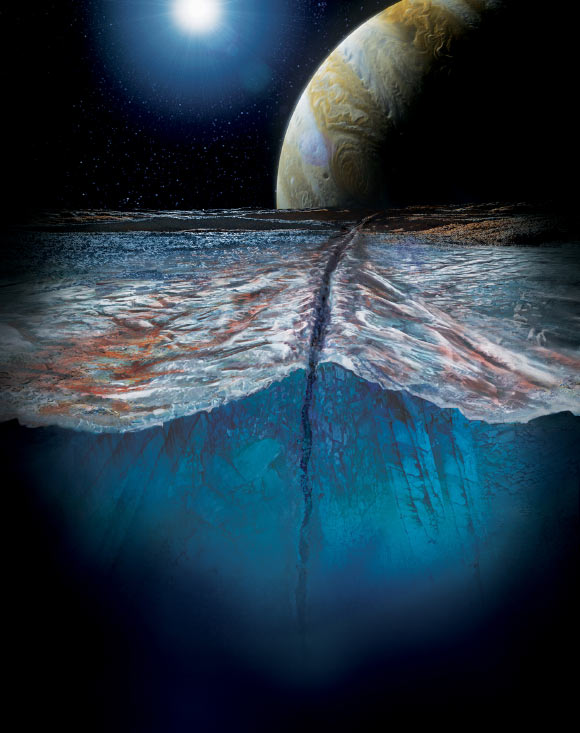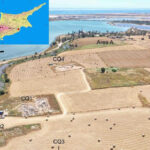The radar properties of icy satellites of Jupiter and Saturn commonly differ by more than an order of magnitude from those of rocky planets because of the lower absorptivity of water ice than that of rock. However, the specific mechanisms behind these differences are not confidently known yet.
An artist’s impression of the surface of Jupiter’s icy moon Europa. Image credit: NASA / JPL-Caltech / SwRI.
“Six different models have been published in an attempt to explain the radar signatures of the icy moons that orbit Jupiter and Saturn,” said Southwest Research Institute senior research scientist Dr. Jason Hofgartner.
“The way these objects scatter radar is drastically different than that of the rocky worlds, such as Mars and Earth, as well as smaller bodies such as asteroids and comets.”
The Jovian and Saturnian moons are also extremely bright, even in areas where they should be darker.
“When we look up at Earth’s moon it looks like a circular disk, even though we know it’s a sphere,” Dr. Hofgartner said.
“Planets and other moons similarly look like disks through telescopes.”
“While making radar observations, the center of the disk is very bright and the edges much darker.”
“The change from center to edge is very different for these icy satellites than for rocky worlds.”
Dr. Hofgartner and his colleague, Dr. Kevin Hand from NASA’s Jet Propulsion Laboratory, argue that the extraordinary radar properties of these satellites, such as their reflectiveness and polarization (the orientation of light waves as they propagate through space) is very likely to be explained by the coherent backscatter opposition effect (CBOE).
“When you’re at opposition, the Sun is positioned directly behind you on the line between you and an object, the surface appears much brighter than it would otherwise,” Dr. Hofgartner said.
“This is known as the opposition effect. In the case of radar, a transmitter stands in for the Sun and a receiver for your eyes.”
“An icy surface has an even stronger opposition effect than normal.”
“For every scattering path of light bouncing through the ice, at opposition there is a path in the exact opposite direction.”
“Because the two paths have precisely the same length, they combine coherently, resulting in further brightening.”
In the 1990s, studies were published stating that the CBOE was one explanation for the anomalous radar signatures of icy satellites, but other explanations could explain the data equally well.
Dr. Hofgartner and Dr. Hand improved the polarization description of the CBOE model and also showed that their modified CBOE model is the only published model that can explain all of the icy satellite radar properties.
“I think that tells us that the surfaces of these objects and their subsurfaces down to many meters are very tortured,” Dr. Hofgartner said.
“They’re not very uniform. Icy rocks dominate the landscape, perhaps looking somewhat like the chaotic mess after a landslide.”
“That would explain why the light is bouncing in so many different directions, giving us these unusual polarization signatures.”
A paper describing the findings was published in the journal Nature Astronomy.
_____
J.D. Hofgartner & K.P. Hand. A continuum of icy satellites’ radar properties explained by the coherent backscatter effect. Nat Astron, published online March 23, 2023; doi: 10.1038/s41550-023-01920-2




